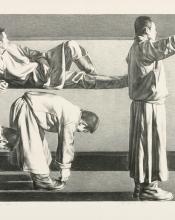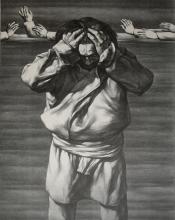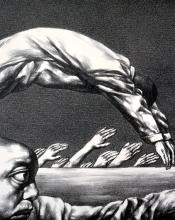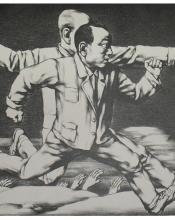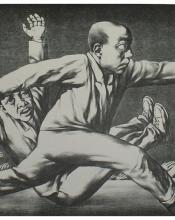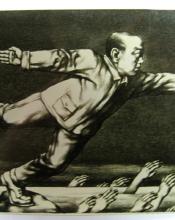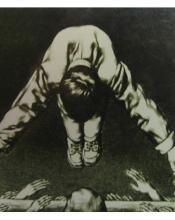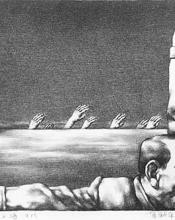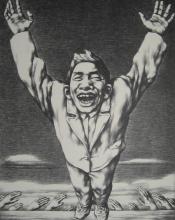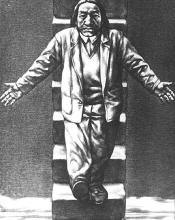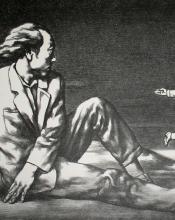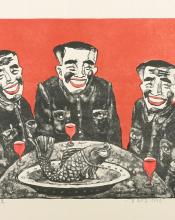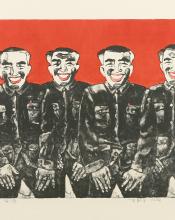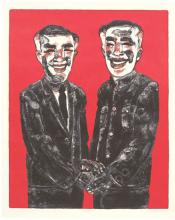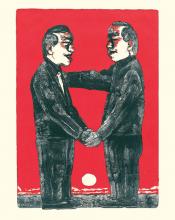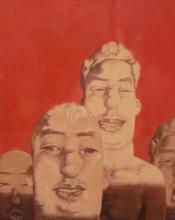Su Xinping
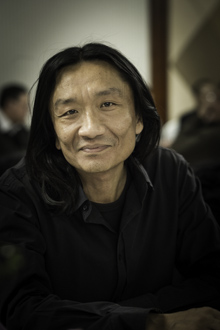
Su Xinping: Allegories of Loss: Jonathan Goodman
China’s booming economy seems to eclipse any individual initiative. So, then, what is it that the artist can do? Does he or she make peace with a society moving evermore efficiently into what has become a worldwide acquisitiveness, which in plainer terms may be called greed? Or does the artist make a stand, no matter how hopeless or unaccompanied, in which the value of introspection is offered as a way of offsetting the mindless enjoyment seen in so much of contemporary life? Because of the role the artist takes on as witness, his or her place in social norms inevitably becomes fraught with the consequences of a moral observation that seems innate to the practice of visual art. One hesitates to sound too conservative by claiming art is inherently ethical, but it seems certain that China’s mid-career generation, including the likes of Cai Guo-Qiang, Xu Bing, and Su Xinping, have kept alive a sense of moral purpose by referring to and reiterating classic, and classical, questions of independence, authenticity, and virtue. Given their popular as well as critical success, it seems to me possible that these artists document the ups and downs of their society with more than a small share of truth, which is what Chinese mores are greatly in need of at present. The current turn towards materialism notwithstanding, it appears that Su Xinping’s generation, old enough to remember both the Cultural Revolution and the democracy movement, sees current social change for what it is—an embrace of things for sale.
The blasted allegories Su returns to again and again in his paintings shed no real light on whatever corrections might be made to better the environment, mental as well as actual, that Chinese people are heir to. Being a painter of psychic truth enables Su to reflect on his views regarding the way people are; the situation is overtly allegorical. Indeed, many of his paintings consist of a single person, recognizably Chinese in descent, standing in a devastated landscape that is, even so, beautiful to look at. The correlation between Su’s tropes of desolation and survival do not necessarily offer more than a hint of hope, but that is what turns his allegorical stance into something more than symbolic. It is a raw but accurate truth that we don’t have much to hold on to, that our despair is in every way an accurate gauge of the extent to which we are slipping in sand. Rather than manipulate these forces, as Cai does, or comment drolly upon them, as Xu does, Su offers his audience the resolute position of someone to whom catastrophe has already happened; his sense of apocalypse, so central to his sensibility and theme, is linked to an optimism whose persistence carries him ever so slightly beyond despair.
In essence, then, Su relates a tragic viewpoint, one muted by the troubles of his time. He does not present resistance so much as he comments on the unfortunate nature of the environment, which is in collision with the grand, more likely grandiose goals of the Chinese. While it seems unfair to deny or lecture about the enveloping contemporary pleasure of cash the Chinese are so attracted to, it seems fair to remark that the phenomenon of twenty-five-year-old artists driving Mercedes Benz sedans makes a mockery not only of the artworld, but of culture and society in general, whose values are trivialized. And sadly enough, the art made by the generation following Su’s is profoundly lacking in the very qualities that have made Su a major painter—a sense of purpose, concern for the environment, and the quest for individuation in a society that values the group over the single person. Su builds an allegorical model because expressing these issues directly would have little effect on the affairs of the general culture; yet he cannot simply remain isolated or reclusive because he himself belongs to a generation bent on interpreting the society at large.
Often in Su’s paintings, we see people raising their glass in a toast, and as a visitor to China, I can comment that this is a ritual enacted again and again. In one affecting work, two Chinese men, both bare-chested, make their toast in what can be read as a post-nuclear landscape, which is detailed as a dark red environment. The sense of desolation is always present in these large works; they belong to a reality that is utterly current but which also refers to the literati landscape that is so much a part of the Chinese cultural tradition. While Su has denied that he is joining with traditional painting, it matters little whether he paints consciously or not his debt to the Chinese art tradition. The legacy of Chinese painting infuses itself into his work even though it makes use of Western materials such as oil paint and canvas; indeed, the very ambition of Su’s conscious attempt to render a treatment symbolic of his present-day circumstances strikes me as classical. The anguish of his lonely figures, cut off in their remoteness, cannot be denied. Yet, interestingly enough, these paintings cannot be regarded only as Chinese—Su’s reading of his situation, its tragic ecological devastation, is increasingly a globalized problem.
Earlier in his career, Su was far more specific about his influences and sites. Trained as a printmaker, first at the Tianjin Institute of Fine Arts, then at the Central Academy of Fine Arts in Beijing, where he received a Master’s degree in 1989 and where he now runs the print-making department, Su first gained recognition making black-and-white prints that documented his childhood in Mongolia. These works come close to being anthropological in their documentation of Mongolian culture; but, at the same time, Su paints parables of psychological and spiritual meaning. In one work from 1995, a central figure is portrayed as diving above the profile of a man with oversized eyes and an extended left arm; behind the two, in the background, we see a group of hands, all of them pointing to the composition’s right. The viewer may feel hard pressed to read the specifics of the print, but it appears true that each element fulfills a symbolic function, even if we remain unsure as to its actual purpose. There is a sense of darkness and foreboding that reappears in Su’s art, lending it an atmosphere of grief. His often-present sense of loss remains key to our understanding of his work, which asks questions as much as answering them.
Sometimes Su beautifully renders horses, a theme he returned to regularly in his career. They seem to be far more innocent than his portraits of people, who, after all, must face their responsibilities in regard to nature. Su never directly judges, but his moral qualms concerning China’s brave new world are nonetheless conveyed. Still, even though it is easy to construe desolation in his work, one does not sense that the artist is specifically judging a class or individual; the general situation appears frightening, but at the same time inexorably fated, so that a sense of uselessness accompanies the greater awareness brought about by his art. The sadness of this state of affairs is not lightly presented; however, they may be read as generally troubled as well as referring to the particulars of Chinese society now. The moral quandary in Su’s art remains unresolved; the group who toasts to a greater health does so in a miasma of polluted air, a real problem in Beijing, where Su lives. As a Westerner, I cannot but react to the part of Su’s work that possesses international overtones, and while I remain deeply aware that Su is a Chinese artist making Chinese art, part of his strength comes from the way in which all of us may participate in his records of abandon, since all of us face similar difficulties.
In fact, unlike the work of Xu and Cai, who imbue their modernist, mostly Western processes with direct references to historical Chinese culture, the art of Su negotiates, in its iconography of loss, a transcendently resonant vulnerability that extends beyond his culture. Certainly, Su cannot be explained as belonging to Western culture, but his imagination is large enough to include a generally human, as opposed to a specifically Chinese, sense of trouble and demoralization. In one of the prints we see, in the foreground, a man lying down on his side; behind him we see the large tail and flanks of a back of a horse. Their disconnected relations are intensified because of the long shadows thrown by the horse and poles between which it stands. The man may be asleep or simply resting, but the ambience is melancholic, asking questions of the viewer that seem impossible to answer. The loss of faith, an existential fall, seems to be central to Su’s dark, atmospheric scenes, that appear to reference humanity in the broadest terms.
Su’s findings seem resolutely pessimistic, in the sense that the world is lost despite the harmony and prosperity the people who toast each other are supposed to bring about. When a toast is made in a gathering at a restaurant, for example, it carries its participants toward an optimism that is communal in nature. Yet the people inhabiting Su’s imagery hardly feel happy or determined to include others within their point of view; instead, they embody an isolation that expresses a discontented view of life. For many of us who belong to the intelligentsia, no matter Asian or Western, Su’s doubt strikes true because it fosters a realistic awareness of the sadness of change, in part because it is so difficult to effect change. However hard, we try to rise above and beyond our fate, even if the mortality we face lends itself at the very least to melancholy if not abjection. When I asked Su whether the landscape in his paintings was globally oriented, in the sense that he was referring to a post-nuclear world, he demurred and said that he was referring to China’s imminent environmental catastrophes. Inevitably, being a Chinese artist originally from the steppes of Mongolia, Su looks to the local for his inspiration. Yet viewers from other landscapes may reason that their situation mimics Su’s, a reading that Su in fact suggests by making his paintings as allegorical as possible.
In Su’s more recent work, the pessimism becomes more explicit as we experience the desolate landscape that he sets before us. In one long horizontal painting, Su’s audience comes up against the ghastly appearance of hills that seem to be part of a strip mine; we follow its ups and downs and fences, as well as an atmosphere that has lost any sense of cohesiveness. It is hard not to read the view as symbolic; however, part of its power is that Su seems to be pointing at an actual scene, combining his allegory with a graphic report based closely on an actual site. This painting is particularly free of cultural allusion; it may be seen as a fierce comment on what we do to the face of the earth. As a site of disastrous ecology, the landscape might be anywhere. Yet we know that the problems are particularly Chinese, who face irreparable harm because of their industrial advances—this despite their exquisite knowledge of and sympathy with nature, as imaged in the Chinese painterly tradition. Su implies, but does not state explicitly, that the changes occurring in China have a price; the cost may well exceed the benefits being incurred.
Works like this beg the question of efficacy in the struggle against ecological catastrophe. It is beyond the power of any single person—especially an artist—to put right the devastations now being visited upon China; at the same time, however, it is up to the intellectual class to call attention to the sad state of affairs, ecologically speaking, that China is now engaging in. Su’s portrayal of isolated figures raising a toast to a ruined landscape paradoxically has the special ability to focus on hope, no matter how small or tattered that hope may be. He comes from a society that not so long ago championed utopias that were unrealizable, yet he does not completely deny the idealism that went along with the suffering the utopias produced. In Chinese culture today, it is hard for a sympathetic Westerner to condemn a social order that only recently has been transformed by materialism, especially when it has come after decades of poverty. Yet, at the same time, the intellectual’s job is to point out the dangers of such an approach, which has already resulted in a consumerism that is all too familiar to visitors from the West. Although Su cannot personally transform his culture, his melancholic art possesses ramifications that extend themselves toward the construction of a measured wariness in regard to consumption. He suggests that the main order of the day is awareness, which hopefully will lead to a focused action. It is true that his paintings offer no avenues of open protest that would result in a better world, but the simple recognition of danger and responsibility leads to a sharper understanding of what China is facing.
Located along a spectrum that begins with nostalgia and ends with panic, Su’s brilliant art enables us to ride the increasing apprehension that something is very wrong in his world,—or our world, for that matter, since the situation is easily made global. Even in the early work, which cannot be read as broadly as the more recent paintings, the realism is mingled with a sense of melancholy if not doom. Su’s figuration allows him to treat the actual world in a way that underscores his sense of fate, which remains mysterious and unreceptive to the point of hostility. If what Su suggests is true, namely, that the world we live in is not only indifferent, it also harbours a deathly ambiguity, then it is our task to transform the negations, both imagined and genuine, that face us. By not demanding that we act, Su is able to present a more complex understanding of this condition, which he can scrutinize to productive effect. The translation of his worries into international terms seems to me inevitable in that his symbolic mode of working intimates a universality anyone might make use of. For example, despite Su’s negative reply to my suggestion that his blasted landscapes suggest a post-nuclear world, as his audience we can still take his position as suggestive of global destruction. The tension, then, between the particulars of Su’s position and the grand scheme that results from our construal of his motives makes his work that much more multifaceted—surely a position of strength in today’s art world.
It is interesting to consider Su as an image-maker within his tradition: Xu Bing, who is a friend of Su’s, suggested to me that his paintings had parallels with works from the Song dynasty, only later to say that Su had denied the affiliation. Even though Su works with oil on canvas, there is little if any precedent for the kind of art he is making within Western figurative art. Certainly there are Western traditions of allegory, but they can’t be imposed as if they were a template from which Su has learned. Yet Su, born in 1960, is old enough to have been schooled in the Socialist Realist style which is heavily indebted to Russian contemporary painting. He eschews the glorification of the peasant from a generation ago; however, he does appear to embrace the common man, in the sense that we feel that those individuals being depicted hardly come from an aristocratic or privileged background. This notion of an Everyman overwhelmed by his environment becomes the scenario to which Su returns, again and again, most likely in the hope that his repeated representation of loneliness would convince his audience of our tragic standing. Again, I am offering a view that sees Su as universal artist, painting with a very wide brush, rather than someone only responding to the details of Chinese life. This happens in part because it is hard to place his work formally; inevitably, though, his method looms larger than the particulars of his designs.
In one of his most impressive paintings, Su’s emblematic figure has been reduced to a shadow making his way through other shadows left by the late light; this takes place in an area either in total desolation or under new construction. It hardly matters how we read the debris and isolated posts and high lamps that litter the twilit, reddish-brown landscape: it is clear that Su is expressing change negatively, as a monster with ruinous consequences. In paintings such as these Su works very large, so that his vision of lost order makes its effect upon the viewer by enveloping him or her within the grand rhetoric of the composition; the sheer scale of the paintings demonstrate Su’s ambition, which is to embody the crisis brought about by China’s extraordinary, grand, and grandiose transformation of its physical context. Gone are the atmospheric lanes, the hutongs that were so charming, in favour of the high-rise, suburbs, and massive road building schemes. The giant expectations of a new society take place quite literally upon the wreckage of old streets, but there is little to offer that is positive in Su’s dark world. We may grant that sadness is a subject concomitant with so much physical reconstruction, as the new living conditions often feel antiseptic, without warmth. Su paints an apocalypse made personal for those who live in China, where the consequences of change render relations distant and impersonal.
Despite all the negativity, one feels that Su is finally celebrating survival. The faces of his figures as they offer a toast don’t seem optimistic so much as they feel resigned to a life made lesser by inevitable “progress.” Like Su himself, they hardly have any way of making a real difference in the vast alterations now occurring in their lives. The pessimism, though, enables Su’s realistic treatment to forge a melancholic beauty that echoes throughout his efforts, early and late. He is an artist of muted anguish, and his sensibility, visible in his vistas of destroyed places, can be seen as epic in its refusal to embrace the past. China of course is a continuous culture, but its present-day life seems vastly different from earlier periods. Su intends not to proscribe any action in the face of change; instead, he depicts the interaction of man and culture on its most basic level. Usually we see allegory as leading to a happy ending; one’s progress in life becomes symbolic of a greater good that is achieved over time. Su, however, is realistic in both his technique and his vision, painting allegories of loss that resonate across cultures and epochs. It is to his credit that he accomplishes his goal with a minimum of rhetoric. It is clear enough that Su offers small solace, but his vision incorporates an element of endurance, which is the least we can ask for and it may well be all we have. His realism survives as we do, under what can only be called straitened circumstances.
|
1960 |
Born in Jining, Inner Mongolia |
|
1977-79 |
Army Service |
|
1983 |
Graduated from Tianjin Institute of Fine Arts, majoring in Painting and |
|
|
Printmaking |
|
|
Instructor, Dept. of Fine Arts of Inner Mongolia Teachers College |
|
1989 |
Graduated from the Central Academy of Fine Arts (CAFA), Beijing, |
|
|
Masters Degree in Printmaking |
|
1998 |
Freeman Fellowship and Residency, Vermont Studio Center, USA |
|
|
Workshops at Elam School of Fine Arts, Wanganui Polytechnic, Dunedin |
|
1999 |
Polytechnic School of Fine Arts, School of Art Lithography |
|
|
Lectured at Dunedin Public Art Gallery, New Zealand |
|
Present: |
Vice President, Professor, Doctoral Tutor, CAFA |
|
Solo Exhibitions
|
|
|
2019 |
Su Xinping: Everything is Still and Timeless, Suzhou Museum, Suzhou |
|
|
Su Xinping, Beijing Minsheng Art Museum |
|
2017 |
Fictional Reality: Su Xinping, United Art Museum, Wuhan |
|
2016 |
Horizon: Su Xinping, Hui Art Space, Beijing |
|
2015 |
Solemn Landscape: Su Xinping, Guangdong Museum of Art & FM Art Space, Guangzhou |
|
|
Su Xinping: Along the Way, Museum of Contemporary Art of CAA., Hangzhou |
|
2014 |
Su Xinping: From Surrealism to Automaticism, Museum of Luxun Academy of Fine Arts, Shenyang |
|
2013 |
Walking Swiftly - Su Xinping, Meilun Art Gallery, Changsha |
|
|
Pending - Su Xinping, Today Art Museum, Beijing |
|
|
Pending - Su Xinping, Art Museum of Nanjing University of the Arts, Nanjing |
|
2009 |
Toasting, Red Mansion Foundation, London |
|
2008 |
Toasting, Xin Beijing Art Gallery, Beijing |
|
|
Toasting, China Square Gallery, New York |
|
|
Toasting, Dolores De Sierra Gallery, Madrid |
|
|
Toasting - Su Xinping (2005 - 2008), He Xiangning Art Museum |
|
2007 |
Landscapes, Today Art Museum, Beijing |
|
2006 |
Su Xinping, Singapore Tyler Print Institute |
|
2005 |
Su Xinping, Red Gate Gallery |
|
|
Su Xinping Portrait Works, NAMOC |
|
|
Su Xinping, Red Gate Gallery |
|
2002 |
Paintings by Su Xinping, Ling Nan Museum, Guangzhou |
|
|
Su Xinping, Portland Art Gallery, Cleveland, USA |
|
2001 |
Flanders Contemporary Art Gallery |
|
2000 |
Outer Appearance and Inner Mindscape, Soobin Art Gallery, |
|
|
Singapore |
|
|
Inner Spirit, Red Gate Gallery |
|
1999 |
Untitled, Dunedin Public Art Gallery, The Octagon, New Zealand |
|
|
Lithographs, Dunedin Community Art Gallery, New Zealand |
|
|
Hope: Recent Paintings, Flanders Contemporary Art Gallery |
|
|
Minneapolis |
|
1998 |
Comrade Series, Red Gate Gallery |
|
|
Recent Lithographs, Exhibition, Workshop and Lecture, LASALLE-SIA |
|
|
College of the Arts, Singapore |
|
|
Mongolia in Transition, White Lotus Gallery, Eugene, Oregon, USA |
|
1997 |
Sea of Desires, Red Gate Gallery |
|
|
Su Xinping, Chinese Contemporary, London |
|
|
Mamalieres, Museum of Contemporary Art, Paris |
|
1996 |
A Decade of Printmaking, Red Gate Gallery |
|
1995 |
Recent Lithographs, Red Gate Gallery |
|
|
LKF - the Gallery, Hong Kong |
|
|
Fire Station Gallery, Sydney |
|
|
Kiang Gallery, Atlanta |
|
1994 |
Seton Hall University, New Jersey |
|
1993 |
Fire Station Gallery, Sydney |
|
|
Kiang Gallery, Atlanta, USA |
|
|
Su Xinping, Red Gate Gallery |
|
|
Su Xinping, Yellow River Gallery, New York |
|
1992 |
Su Xinping, NAMOC, Beijing |
|
|
Su Xinping, Red Gate Gallery |
|
1991 |
Su Xinping Lithographs, Shanghai Art Museum |
|
1990 |
Su Xinping at Gallery 13, Hong Kong |
|
Group Exhibitions
|
|
|
2018 |
Facing East: Chinese Contemporary Art of the 1960s, Shanghai New Gallery of Art, Shanghai |
|
2017 |
Red Gate on the Move, Red Gate Gallery |
|
2016 |
Post Academy - Research Exhibition of The Eight Academies of Fine Arts’ Oil Painting, Art Museum of GAFA, Guangzhou |
|
|
The Jumble of Growth: The Third Today’s Documents, Today Art Museum, Beijing |
|
2015 |
CHINA 8 – Contemporary Art from China on the Rhine and Ruhr, NRW-Forum Düsseldorf, Germany |
|
|
Tradition and Innovation: The Human Figure in Contemporary Chinese Art , Chazen Museum of Art, University of Wisconsin-Madison, Madison, U.S.A |
|
2014 |
Master Mould and Copy Room, CAFA Art Museum, Beijing |
|
|
Chinese New Expressionism: Special Invitation 1980 - 2014, China Art Museum, Shanghai |
|
|
Future Returns: Contemporary Art from China, Eli and Edythe Broad Art Museum at Michigan State University, East Lansing,USA |
|
|
The 2nd CAFAM Biennale - The Invisible Hand: Curating as Gesture, CAFA Art Museum, Beijing, China |
|
2013 |
Portrait of the Times: 30 Years of Chinese Contemporary Art, Power Station of Art, Shanghai |
|
2012 |
Paper - Non Paper: 1st China and Japan Paper Art, CAFA Art Museum, Beijing |
|
|
In Time: Chinese Oil Painting Biennale, National Art Museum of China, Beijing |
|
|
Openness and Integration - Contemporary Chinese Art, Museum of Fine Art, Budapest, Hungary |
|
|
Art Front - Contemporary Art, Songzhuang Art Museum, Beijing |
|
|
Visionary: Contemporary Fine Art from China CAFA, Wimbledon College of Art & Art @ Golden Square, London |
|
|
Duchamp Influence in Painting / First Zhuangzi International Conference Parallel Exhibition, Beijing Yuan Art Museum, Beijing |
|
|
Two Generations - 20 Years of Chinese Contemporary Art Australian Tour: City of Sydney Chinese New Year; Manning Regional Gallery; Damien Minton Gallery; University of Newcastle Gallery; Melbourne International Fine Arts (MiFA); Linton & Kay, Perth |
|
2011 |
The Force from Academy, Wuhan Art Museum, Wuhan A New Horizon – Contemporary Chinese Art, National Museum of Australia, Canberra |
|
|
Window in the Wall: India and China – Imaginary Conversations, Pearl Lam Fine Art, Shanghai |
|
|
20 Years - Two Generations of Artists at Red Gate, island6 Art Center, Shanghai |
|
|
20 Years - Two Generations of Artists at Red Gate, Red Gate Gallery |
|
2010 |
Asian Art Biennale, Bengal |
|
2009 |
Evidence, AYE Gallery, Beijing |
|
|
Yi Pai – Century Thinking, Today Art Museum, Beijing |
|
|
1st Contemporary China Engraving Academic Exhibition, Today Art Museum, Beijing |
|
|
Chengdu Biennale, Chengdu. |
|
2008 |
Shanghai Biennale, Shanghai |
|
|
Red Gate Stars, Red Gate Gallery |
|
2006 |
China Today, National Art Museum of China |
|
|
Red Gate Gallery 15th Anniversary |
|
2005 |
11th India International Triennial, India |
|
|
Wall – Chinese Contemporary Art, Beijing Millennium Art Museum; |
|
|
UB Anderson Gallery, Albright-Knox Art Gallery, New York |
|
2004 |
Cinesi- artisti Fra tradizione e presente, Italy |
|
2003 |
New Generation and Post – Revolution, China Blue Gallery, Beijing |
|
|
An Opening Era – 40th Anniversary of the Founding of CAFA, CAFA |
|
|
Chinese Art Today, China Millennium Monument Art Museum, Beijing |
|
|
1st Beijing International Art Biennale, NAGC, Beijing |
|
2002 |
Guangzhou Chinese Artists Triennial, Guangzhou Art Museum |
|
2001 |
China Art Now!, Singapore Art Museum |
|
|
Clues to the Future – Red Gate Gallery’s 10th Anniversary |
|
|
1st Chengdu Biennale, Chengdu Contemporary Art Museum |
|
2000 |
Inside Out: New Chinese Art, National Gallery of Australia, |
|
|
Canberra, Hong Kong Museum |
|
1999 |
Urban Yearnings: Portraits of Contemporary China by Liu Qinghe, Su |
|
|
Xinping and Zhang Yajie, Chinese Culture Center, San Francisco |
|
|
Inside Out: New Chinese Art, San Francisco Museum of Modern Art |
|
|
China 1999, Limn Gallery, San Francisco |
|
|
Square Studio, Konrad Adenauer Foundation Center, Bonn, Germany |
|
|
Square Studio, Shenzhen Art Museum |
|
|
Tree of Life, Qingping Gallery, Boston |
|
1998 |
In & Out Contemporary Chinese Art from China and Australia, Plimsoll |
|
|
Gallery, Tasmania School of the Arts, Hobart |
|
|
Faces and Bodies of the Middle Kingdom, Galerie Otso, Espoo, Finland |
|
|
Eastern Approaches, Brunel University, UK |
|
|
Inside Out: New Chinese Art, Asia Society Galleries, New York |
|
|
Retake: A Selection Reviewing Red Gate Artists’ Signature Works |
|
|
Curated by Carolyn Fitzpatrick, Red Gate Gallery |
|
|
Political Pop Art Works from China, Max Protetch Gallery, New York |
|
|
1st Exhibition of Square Studio, International Art Palace Gallery, Beijing |
|
|
Chinese in Verduno City, Art Inside the Castle, Italy |
|
|
Chinese New Art , Asian Association Museum, New York, PSI Museum |
|
1997 |
Three Printmakers from CAFA, Red Gate Gallery |
|
|
World Prints, Portland Art Museum, Oregon |
|
|
In & Out - Contemporary Chinese Art of the Mainland & Diaspora, Australia |
|
|
Faces and Bodies of the Middle Kingdom, Galerie Rudolfinum, Prague |
|
|
New Art from China, Flanders Gallery, San Francisco |
|
|
World Triennial of Prints, Paris |
|
|
New Art from China, Marco Polo Gallery, USA |
|
|
4thTriennale Mondiale d’ Estampes Petit Format, Chamalieres, |
|
|
Auvergne France |
|
|
8th International Biennial Print & Drawing, Taipei Fine Arts Museum |
|
|
In & Out Contemporary Chinese Art from China & Australia, RMIT |
|
|
Gallery, Sydney College of the Arts, Melbourne |
|
1996 |
People’s Progress - 20th Century Chinese Woodcuts, Art Gallery of |
|
|
New South Wales, Australia |
|
|
Contemporary Chinese Prints, Portland Art Museum, Oregon |
|
|
Asia Print Art Festival, Pusan Cultural Centre, Korea |
|
1995 |
Chinese Avant-Garde, Art Museum of Gothenburg, Sweden |
|
|
Chinese Contemporary Art, Meridian Gallery, Australia |
|
1993 |
Painter's Den, International Art Palace Gallery, Beijing |
|
|
6th International Biennial of Prints and Drawing in Taiwan, Taipei Fine |
|
|
Arts Museum |
|
|
Nominating Exhibition, UNESCO, International Art Palace, Beijing |
|
|
Taiwan International Invitational of Prints, Kanagawa, Japan |
|
1992 |
Modern Chinese Prints, Rome |
|
1991 |
Sapporo International Print Biennial Exhibition, Sapporo, Japan |
|
|
World Triennial of Small Prints, Museum of Modern Art, France |
|
|
Osaka International Prints Triennial Exhibition, Osaka, Japan |
|
1990 |
New Works by New Chinese Artists, NAGC |
|
|
Prints from Four Asian Countries, Chiba Art Gallery, Japan |
|
1989 |
China Avant-Garde, NAGC |
|
|
Modern Chinese Prints, Shanghai Art Gallery |
|
Awards |
|
|
2005 |
Singapore Tyler Print Institute – Visiting Artists Program |
|
1998 |
Scholarship for Vermont Artists-in-Residence, USA |
|
1994 |
Excellence Prize, China Art Expo, Guangzhou |
|
|
Excellence Prize, Shenzhen Art Expo |
|
|
Silver Medal, 12th National Exhibition of Prints, Guangzhou |
|
1993 |
Nominated as candidate for UNESCO Award for the Promotion of Arts |
|
1992 |
Excellence Prize, 20th Century - China Exhibition, NAGC |
|
1991 |
Outstanding Prize, Beijing – Taipei of Contemporary Prints, |
|
|
CAFA |
|
|
Excellence Prize, World Triennial of Small Prints, Museum of Modern |
|
|
Art, France |
|
1989 |
Bronze Medal, 11th National Exhibition of Prints, CAFA |
|
|
Grand Prize, Young Printmakers from the Mainland, San Yuan Se Art |
|
|
Center, Taipei |
|
|
Bronze Medal, 7th National Art Exhibition of China, NAGC |
|
|
Excellence Prize, National Exhibition of Prints by Young Artists, |
|
|
Shanghai Art Gallery |
Collections
Shenzhen Museum; Asia Pacific Museum, USA; British Museum, England; Art Gallery of New South Wales, Australia; National Gallery of Australia; National Gallery of Victoria, Australia; Portland Art Museum, U.S.A.; Shanghai Art Museum; NAMOC; Seton Hall University, USA; Yokohama Art Gallery, Japan; Fukuoka Art Museum, Japan; Ludwig Museum, Germany; Gallerie Otso, Finland; San Francisco Museum; Jundt Art Museum, USA ; Ashmolean Museum , University of Oxford, U.K.; British Library, U.K.; Red Mansion Foundation, U.K.; Singapore Art Museum, Singapore; Museum of Singapore University, Singapore;
NAMOC, Beijing; CAFA Art Museum, Beijing; Guangdong Art Museum; Qingdao Art Museum;
Jiangsu Art Museum; He Xiangning Art Museum, Shenzhen; Today Art Museum, Beijing; USC Pacific Asia Museum and private collections around the world.
My recent work is about two themes – the urban landscape series and the toasting series. In the urban landscape series I want to express the impact of urbanisation on people. In the toasting series I use irony to reveal issues of city life and the interaction of people – particularly in business and politics.




